In the spring of 2002, Hideki Kozima and Cocoro Nakagawa started desiging and engineering a simple interactive robot for the study of early communication development in human infants. The grand objective was, as in building Infanoid, "Embodyment that derives spontaneous and intuitive communicative actions from infants and children". In contrast to Infanoid, we especially focused our efforts on safety and comprehensiveness issues in the course of designing.
In the early stage of the designing, we simply thought that "it would be wonderful if this stuffed dog (below) is able to exchange attention and emotion with people". The stuffed dog we picked up as a model was the one had been used for joint attention expriments with Infanoid. We tried to put 8 motors and control thingy into the 100mm-tall body, but ended up with a CAD image of a bulky 200mm-tall mecha that gave us almost no cuteness, neither to infants.
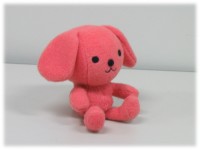
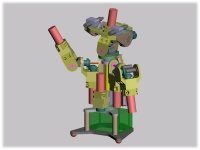
Starting from building a robotic stuffed dog (the model and the CAD image)
We started again from the scratch. We synthesize the shape and motion from the the very basic functions for exchanging attention and emotion with infants. First, the robot should be able to express its attention (e.g., gaze direction), so we gave the robot something like a spherical/cylindrical shape with sensors (e.g., eyes) on its front surface. By panning and tilting this blob, we can express the direction of attention. Next, the robot should be able to express its emotion (e.g., happiness and excitement), so we gave the robot some capabilities of bobbing, rocking, and shaking the body. Since we planned to use Keepon also for autism research, we decided not to add facial features like actuated eye-brows or mouth, which might be intimidating for those children.
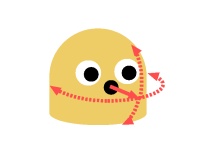
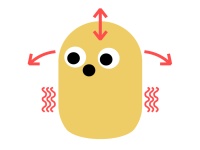
The vital expressive functions: attentiveness and emotiveness.
From these expressive functions, possible appearance of the robot naturally emerged. We use a silicone-rubber body for safety. By actuating the elastic body, Keepon expresses its attention and emotion. The neck/waist wrinkle is for making naturalistic deformation of the body. The body should be as hollow as possible for safety and naturalistic deformation, so we put the motors and PCBs out of the body into the cylinder below. This is the minimal design of Keepon.
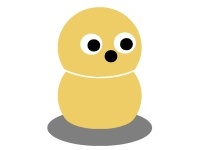
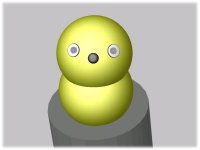
Embodiment and realization
Having finished the functional designing, we proceeded to mechanical engineering to make it work out. We used two degrees of freedom, namely "pan" and "tilt", for attentive expression, and another two degrees of freedom, namely "side" and "pon", for emotive expression. Also, making some rattles or vibrations on these motors, we could also express some additional information about the internal states of Keepon.
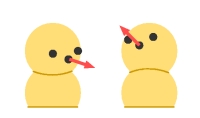
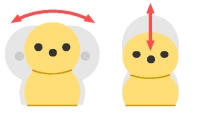
Attentive actions (by 2 DOF) and emotive actions (by 2 DOF)
We put the four motors and two PCBs (for motion control and motor drive) into the black cylinder, on top of which we mounted the yellow body of Keepon. For the horizontal rotation of the body, namely "pan", a motor rotates the whole internal structure. For the vertical bobbing, namely "pon", a motor drives a winch that winds up a wire, pulling down the body; a spring in the neck rewinds the wire. For "tilt" and "side", whose pivots come to the center of the lower body, we use a pair of gimbals that are paralleled with each other by four wires.
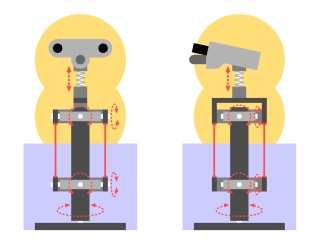
Actuation mechanism of Keepon
Just like a marionette (upside down), whenever the lower gimbal is actuated by two motors, the upper moves in the same way. This mechanism gives a lot of hallow space inside the yellow body, which can then be deformed naturally by the postural motion and by the force applied from outside.
Finally, we put this driving mechanism with four motors, two PCBs (Pico-2 and Poco-14), as shown below. The silicone-rubber body (120mm tall and 80mm in diameter) and the black cylinder (150mm tall and 110mm in diameter) are not present here.
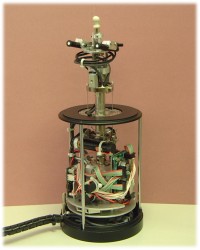
Keepon's internal structure
You can see the upper gimbal above the black ring-top, four thin wires that connect the upper gimbal to the lower one. The lower gimble is barely visible, since a motor (for "tilt") is attached to it. At the center of the four wires, you can see the "spine", through which a "pon" wire goes.
You can also see some facial features, especially the cameras (Elmo QN42H + 1.8mm lens). The microphone (SONY ECM-77B) is not very salient here. The protruding thing at the top of the head is the connecting point to the skin, at which postural force applies to the body. For example, when Keepon makes "pon", this connecting point pulls down the skin (skull). At most lower part of the cylinder, the cables for cameras, microphone, power (DC12V), and communication (RS-485) are coiled up together, so that the internal structure rotates (−180 to +180 deg) without giving heavy stress to the cables.
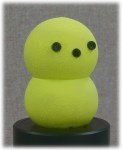
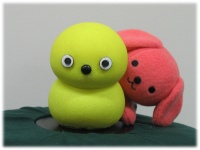
The first prototype (2003) and the first modification (2003)
Finally, we added eye-pieces and a nose-piece, which were made by 3D printer, for more eye-like and nose-like features. This is the current version of Keepon. We believe that Keepon is as cute and comprehensive as the stuffed animal, which have been inspiring us throughout this project.
